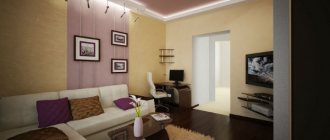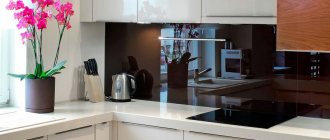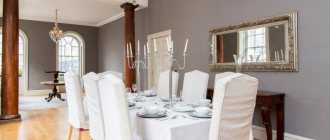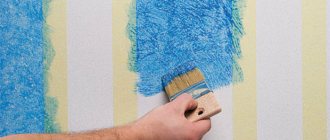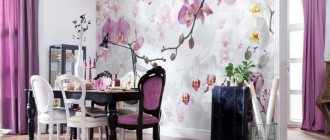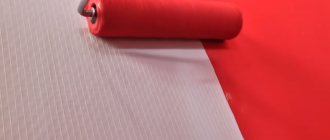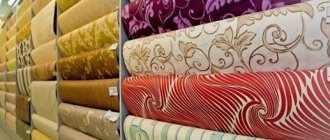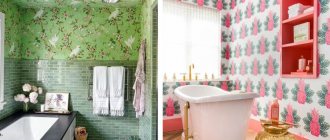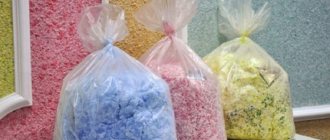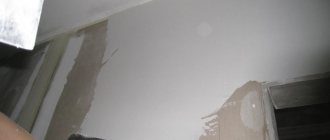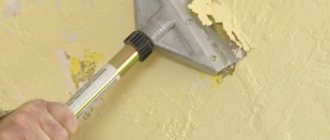Decorating walls in rooms is a labor-intensive type of work. For this reason, apartment and house owners choose foundations that are easy to maintain and use. One of the acceptable options is wallpaper. If these are rolled varieties with texture, they serve as decorations and hide defects on the surface. Next, we’ll look at how to glue wallpaper for painting.
How to prepare the surface
The results of the work depend on how the surface is prepared. It is important to make sure that after this the walls meet certain requirements. In this case, the preparation technology involves the following steps:
- To begin with, the entire apartment is disconnected from electricity. Otherwise, sockets and switches cannot be removed from their mounting location in a safe way. It is better to take separate care of the wire insulation.
- The previous finishing material is removed if the room is old. The trellises are soaked, removed manually, or spatulas are used. The tiles are bleached. Paint is removed mechanically or with chemical compounds. The main thing is to preheat the layer using a hair dryer. A warm soapy solution helps remove the whitewash before gluing.
- Antibacterial impregnations are used to treat suspicious areas associated with a high risk of fungi and mold formation.
- The joints between ceilings and walls and floors receive the most attention. It is necessary to level the surface so that only right angles are preserved. Then it will be easier to glue wallpaper for painting.
- The surface is treated with a primer, then adhesion between surfaces becomes better. The easiest way is when the repair is completely done by hired craftsmen.
All you have to do is wait until the primer dries, then proceed with subsequent work with glue.
Marking and cutting
The main thing is that the sections of wallpaper are connected to the surface as evenly as possible. Otherwise, the appearance will only worsen with each new trellis. Creating markings before moving on to other stages protects against such troubles when processing walls.
The sequence of work is not so complicated:
- First, choose a corner with wallpaper from which to start working. This is usually the wall on which the window is located. This is how a starting point is chosen. A distance equal to the width of the purchased trellises is marked from the edge. Subtract 2-3 cm from the value. This is the so-called pass for arranging corners.
- Ideally straight vertical lines are marked using a plumb line. This is a guideline for further work, including along the edges.
- Use a starting strip drawn in pencil. We retreat from it a distance identical to the width of the trellis. After this, draw a second line. This marking technology is used for all walls. Then it will be impossible to fix the pasted wallpaper.
- After this, they move on to cutting the roll. The distance from floor to ceiling is measured using a tape measure. This needs to be done in several places. A 10 cm margin is added to the results. The use of baguettes involves reducing this figure to 3 cm. Then a construction knife is taken for leveling.
Particular care is required when working with glass wallpaper. The respirator provides complete protection against damage. Then the materials will be glued without harm to health.
If the walls are painted without wallpaper, the surface must be perfect. Otherwise, most of the defects will be visible on it. Thanks to the wallpaper, this issue is partly removed. The canvases will be easy to remove and repaint in a different color if necessary.
Wallpapering
Wallpaper strips prepared for gluing are treated with glue and folded in such a way that the surface treated with glue touches each other, after which they are rolled into a loose roll. It is advisable to prepare 5-7 strips at once. The strips coated with glue should lie for 15-30 minutes to ensure that the substrate is evenly saturated with glue.
After this, using a roller, apply glue to the wall to a width slightly greater than the width of the wallpaper strip. Try not to stain the ceiling with glue. The first strip is glued from the window along a vertical line marked with lace and paint. Never focus on corners - they are often crooked.
The strip is smoothed first in the middle, then, displacing air and excess glue, to the edges, from top to bottom. The canvases are glued end-to-end, as tightly as possible to each other, but without overlaps. After gluing, the edges of the strips are rolled with a rubber wallpaper roller.
Smooth out the stripes only with a plastic wallpaper spatula. Excess glue is removed with a damp cloth or foam sponge. All work must be carried out with windows and doors closed. They can be opened only after the wallpaper has completely dried - after 2-3 days.
We glue paper wallpaper and vinyl wallpaper on a paper backing
There are practically no differences here from working with conventional trellises. The canvases themselves in this case are distinguished by increased thickness and length. Wallpapering for painting has the following nuances:
- The cut sheets are laid out on the floor. The main thing is that the surface is smooth and clean.
- The back side is covered with adhesive. A maklovitz brush is a must-have device for carrying out work. Corners and edges of canvases are the weakest points; they are handled especially carefully. No part of the materials should protrude.
- It is unacceptable to leave areas that have not been coated. Otherwise, air bubbles will form. It is best to use glue with special additional indicators. A special dye in the composition helps to evenly distribute the material over the surface. The adhesive becomes transparent when it dries.
- The strip is folded like an accordion or in half. Then the sheet is better saturated with the composition. The adhesive for processing is selected depending on what base is used.
- While the base is impregnated with the composition, you can cover the walls with a thin layer of the mixture. The area behind the marking line is also captured, but not much. Excess glue is removed in a couple of minutes.
- The starting strip is fixed in its place. The main thing is to glue it clearly and evenly in accordance with the markings.
- Air and excess glue are expelled with rollers and spatulas. Use a sponge or rag to get rid of any remaining glue. It is important to ensure that tools and materials do not dry out too much.
- The entire wall is covered using this principle. The next strips go end-to-end with the previous ones. The edges must be placed close to each other, because after drying the paper shrinks somewhat. You need to be especially careful in corners and near openings.
- After drying, get rid of excess edges, very carefully, otherwise gluing will not give good results.
The process is simple, everyone can figure out how to properly glue wallpaper.
Wallpapering for painting: tools and materials
How to organize wallpapering so as not to spoil its appearance? This question worries everyone, since often in order to save the budget one has to refuse the services of specialists. Under no circumstances should wallpaper be wiped with a regular rag, as was done when using old wallpaper. It is very important that the process does not cause any damage to the embossing.
Wallpapering tools
9 main materials and tools come to the rescue:
- Soft and elastic brush;
- Paint roller;
- Glue;
- Additives for coloring;
- Paints;
- Construction tape;
- Stationery knife;
- Putty knife;
- Acrylic primer.
Please note that the glue used for this work should be applied exclusively to the wall. This will not only save material consumption, but also simplify the work process. If you apply glue to the wallpaper, the texture may peel off and it will not be possible to save the material.
Article on the topic: Black bathroom - correctly dose the color
Non-woven wallpaper is convenient because if an error was made during gluing, it can be corrected by simply pulling the edge of the material. Such manipulations can stretch the tape and control all imperfections.
Pasting in corners and near openings
The wallpaper in these places always overlaps; the materials do not affect the process. Coloring involves actions performed in the following order:
- Part of the strip with a width of up to 5-7 cm is inserted on each side.
- The resulting overlap is carefully trimmed in the middle. It is imperative to remove the strips that turn out to be superfluous. The main thing is that the material overlaps on each side.
- Roll the resulting edges with a plastic roller with strong pressure. All irregularities are corrected.
When the wallpaper glue for painting dries, the owners will see a neat seam with nothing superfluous.
Wallpaper for painting: how, when and what to paint with
A minimum of 24 hours should pass between gluing the canvases and painting them. That is, the surface should become completely dry. This is required for any wallpaper to be painted.
Fiberglass wallpapers are known for their finely porous structure, which distinguishes them from their analogues. Because of this, the paint is absorbed very strongly. For this reason, a thin layer of primer is required to be applied to the surface. Regular glue is suitable, diluted in a ratio of 50 grams per 5 liters of water.
Paint the surface with one of the following compositions:
- latex;
- acrylic;
- water-based with the addition of glue.
The color of water-based paint is white. You will have to tint the composition to get the desired shade. It is difficult to obtain such a tone again, so it is often diluted once for the entire volume of the room.
Using the adhesive mixture will not cause any trouble if the following conditions are met:
- It is better to use paint rollers of different sizes for the job. And any type of paint is suitable for this.
- Paint the entire room at once. Otherwise, the shade will turn out with noticeable transitions.
- Joints and hard-to-reach places are painted over first. Then they roll the entire surface, from top to bottom. This also applies to corners; standard tools are too large for them.
- The next layers are applied only when the previous ones are dry.
Paint selection
Selecting a suitable paint and varnish composition for painting wallpaper with your own hands is no less important a task than purchasing wallpaper. Incorrectly chosen paint will lead to damage to expensive material.
Water-dispersion and water-based paints are suitable for all types of wallpaper. Paints and varnishes of this type containing polyvinyl acetate, acrylates or silicone are available on the market. The highest quality and most expensive paint is silicone based. Water-soluble paints do not contain complex aggressive organics, which are not only undesirable for wallpaper, but also release toxins.
Water-soluble compounds have a basic white color. If necessary, the paint is tinted to the desired shade using pigment substances purchased separately. The entire volume of tinted paint should be prepared immediately, and not in parts. If this rule is neglected, it will no longer be possible to repeat the desired tone, since the slightest change in the proportion of components changes the color.
Do not use alkyd or oil-based paints and varnishes for painting wallpaper. They are distinguished by high viscosity and density of structure, and a pungent odor (due to the presence of organic chemicals in them). Alkyd and oil paints are applied to the surface in a thick layer, as a result of which the natural structure of the wallpaper is disrupted and its ability to “breathe” is reduced.
Advice! When purchasing wallpaper and paints, it is recommended to have at least a rough sketch of the decoration. Moreover, it is advisable to provide several options at once in order to be able to compare.
It is not recommended to use foam rollers for painting canvases. After their use, small air bubbles remain on the surface, which is not only unsightly, but also leads to further deformation of the coating.
The table below shows the recommended types of dyes for the most popular types of wallpaper.
| Wallpaper type | Dye |
| Non-woven | Water-based (glossy or matte), acrylic |
| Paper base | Water-based (glossy or matte) |
| Glass wallpaper | Acrylic, latex |

